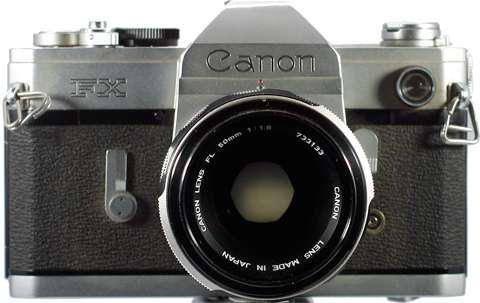
Lens Mount: FL bayonet/breech
Approx. dates of manufacture: 1964 to 1966
Approx. original price: $154.95
Approx. street value: Low
In the 1950s and 60s, a lot of 35mm camera companies began offering interchangable lenses, and almost all of them were screw mount. That means the lens had threads on the end of it, and the camera body had threads, and you simply screwed the lens on and off. Screw mounts were great because they were low tech and they were somewhat standardized; you could buy different brands of lenses and camera bodies and mix and match and swap. The independent lens companies loved this, since they could make one lens that fit a lot of different cameras. You can still find a lot of screw-mount stuff at swap meets and yard sales.
But screw-mounts had a lot of problems. It was fairly easy to cross-thread them and jam them onto the camera, and then the threads had to be cleaned up to make it fit again. They could be screwed tight, but it was also easy to inadvertantly loosen them as well. Or screw them on gorilla-tight to where it next to impossible to get them off again.
More importantly, screw mounts did not allow the lens to ever fit with precision in the same place every time, since the lens could be rotated differently depending on how hard the user twisted. Screw mounts were fine for cameras with simple meters, but if you wanted to get to the next level and control the lens automatically, then you needed pins and levers that connected with precision to the camera body.
So in the 60s the bayonet-mount lenses began to appear in earnest. With a bayonet mount, a lens was pushed on and then given a twist until it locked into position. No more cross-threading. No more accidentally loosening the lens by turning it backwards, because bayonets required a button to be pushed to release the lens. Lenses were held cleanly and securely. And they always locked into the same position every time.
Plus they helped lock users into camera systems, since the lenses and bodies were no longer cross-compatible. Thus when a photographer with ten Nikon mount lenses was looking at buying a new camera body, he was infinitely more likely to choose a Nikon than a Canon, simply because he could keep his lenses. And vice versa. Something similar would happen with the on-camera flashes in the 1970s, when flash units began synching with the camera using a hot shoe instead of a standard cord. The hot shoe allowed a flash to do more with the camera than a simple sync cord could do; but every camera maker's hot shoe was special and incompatible with everyone else's. No more mix-n-matching of accessories.
.jpg)
Canon began producing 35mm SLRs in the 1960s, but they evolved. In 1964, Canon brought out the FX, which took a series of bayonet-mount (actually breech-lock, but I consider it functionally the same thing) lenses, and inaugurated their F-series cameras. Canon claims that the F stood for "flex." Previous Canon SLRs were called Canonflex. But I think they were more influenced by the Nikon F than they care to admit. Canon called their new mount the FL series and began bringing out other cameras that used it: the FP, Pellix, TL and FT.
The FL mount lenses allowed the camera to meter through-the-lens (TTL), which improved the accuracy of metering and determining good exposure. But they had a problem. They had to be stopped-down, meaning the photographer had to turn the aperture down until he got the meter reading he wanted, and then shoot. Closing down the aperture darkened the image in the viewfinder, making composition a lot harder.
Canon would fix this by changing to the FD series of lenses, which were nearly identical except that the photographer could use the meter while the lens was wide open, and the camera would meter properly and stop the lens down automatically when the shutter button was pressed. This was big leap in convenience; and the FD series lenses were so successful that Canon used the mount for the next 30 years. It wouldn't be until the 1990s when their EOS series of autofocus cameras rendered them obsolete.
So back to the FX. Canon liked to introduce important new cameras in pairs: one had the new bells and whistles, while a cut-down version, which was essentially the same camera, had fewer features and a lower price. The idea was that someone who was leery of the new technology, or couldn't afford it, would buy the little brother instead. They did this with the AE-1 and the AT-1, for instance, and the FT and TL. The FX's little brother was the FP. Aside from a few spec differences (like top shutter speed), the major difference between them is metering. The FX had a built-in meter; the FT had none. If you wanted to meter with the FT, you either had to use a hand-held meter or buy Canon's accessory meter which clipped onto the accessory shoe; and if you're going to do that—why not buy the FX in the first place? (I never see FPs for sale; I doubt they sold well.)
Even though the FX introduced FL lenses, it was really doomed from the start because the FX had an external meter sensor (it's on the left-side of the camera body) and a needle readout on the top of the camera housing. When the Pellix and FT came out a couple years later, they used through-the-lens (TTL) metering, and that made the FX obsolete.
For more information: Canon Camera Museum
Camera manual: Orphan Cameras.com



